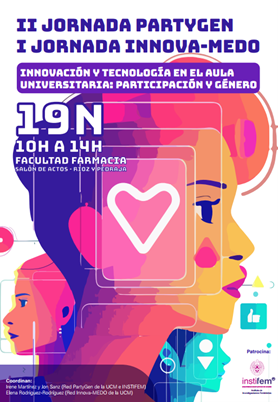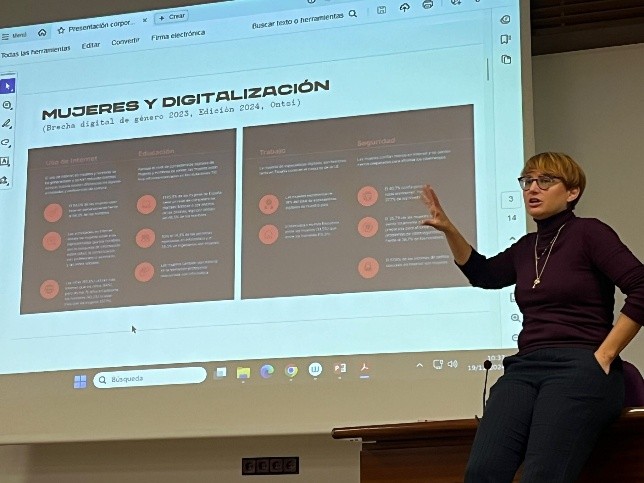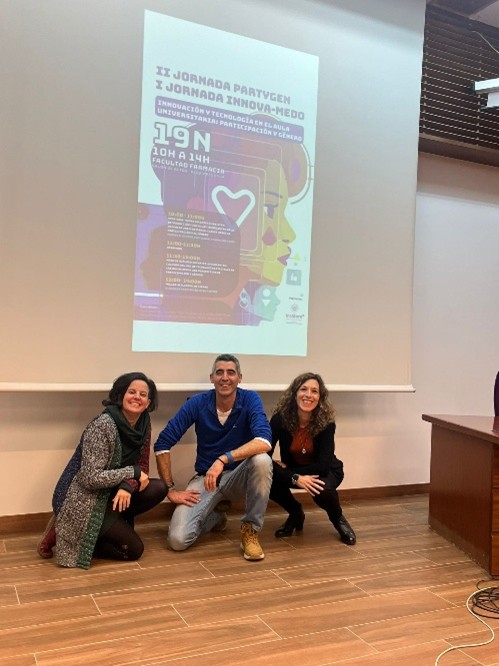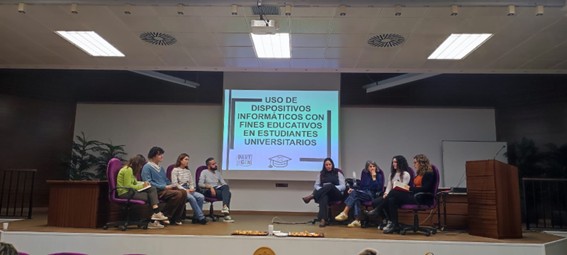Technologies in University Classrooms: Perspectives on Participation and Gender

This event was dedicated to a critical reflection on innovation and technology in university teaching, with a central focus on participation and gender. Among other key issues, we asked: How are we currently using technology in university classrooms? From what perspectives are we integrating it? Are we aware of and do we have evidence of its benefits and the biases it reproduces?
The starting point for this reflection was a pilot survey conducted among students at the UCM Faculty of Pharmacy. The main findings (Rodríguez, et al., 2025) highlighted: a) The most used devices for academic tasks (both inside and outside the classroom) are laptops and mobile phones, primarily for communicating with faculty and for class assignments. b) 100% of respondents identify WhatsApp as the main communication tool. c) The majority perceive that technologies improve the classroom climate and participation, especially in large groups. d) It is acknowledged that the use of ICT is also a source of distraction and can dehumanize student-teacher relationships. e) No significant gender differences were found in overall usage, but differences exist in self-perception and type of use, indicating that classic gender biases persist and are reproduced when technologies are integrated.
As Ainara Zubillaga (2024) notes, curricular innovation transcends the mere updating of content, the adoption of novel methodologies, or the use of technology. It entails a profound transformation of teaching that must respond to the needs of a changing world, centring the reflection on the “why” (for what purpose) of technology use. Educational innovation is, therefore, an intentional and planned process seeking to improve the quality and relevance of educational and social processes.

Within this framework, the work of these teaching networks focuses on the perceptions of both students and faculty regarding technology use and its impact on creating spaces of trust, co-responsibility, and participation in teaching. Three key axes linking technology with participation and gender approaches have been identified (Martínez y Sanz, 2023):
- Gender Differences: Classic gender biases persist in the classroom, manifested in patriarchal roles and stereotypes, participation dynamics in large groups, and differences in self-perception (women perceive themselves less favourably). Regarding technology, women show greater attention to the creative and visual aspect and less to content, and they participate less in technological development, though they have a higher presence in biotechnology, for example. It is essential to incorporate an intersectional perspective to address biases related to class, ethnicity, language, and identities, exploring the reality of technology’s impact on classroom dynamics, gaps, and inequalities.
- Participation: Technologies can bridge participation gaps, and their use is increasing, largely tied to active methodologies. However, there is evidence of limited critical thinking in their application and use. Furthermore, while they facilitate participation in dynamics like large groups, this is not always the case in small groups, and they can lead to dehumanization and the reproduction of fake news or unverified content. It is urgent to incorporate an ethical and critical perspective into these uses.
- Challenges: Based on the identified problems, it is proposed to reflect upon and incorporate the following dimensions into the debate on the use of ICT in university teaching: the absence of critical and participatory discourse in ICT use, dehumanization, the tension between Devices and Culture of Use, the confusion between University Digitalization and Digitizing the Strategy, the dichotomy between the Urgent and the Important, the contrast between the Instrumental and the Processual Approach, and the persistence of unidirectional, non-participatory training.

From these conclusions, the following central questions emerge: What is the purpose of ICT in university classrooms? What approach do faculty take? Who is responsible for teaching responsible and critical digitalization at the university? How do we include an intersectional gender perspective in the use of ICT?
In summary, the PartyGen and InnovaMedo conferences conclude that technological integration must go beyond the adoption of “fun” or “flashy” tools. The key is not the quantity of devices, but the “why” and the “how” they are integrated into the teaching-learning process with a critical approach.
The debate highlights a paradox: technologies have the potential to democratize participation and improve the classroom climate, but they can also reproduce gender biases (as well as class, ethnic, or ableist biases) and dehumanize interactions if they are not addressed with a critical and reflective focus.
Evidence indicates that, while the gender gap in access to technology has narrowed, the gap in self-perception and type of use persists. This demands faculty training that, beyond technical skills, promotes confidence and challenges ingrained stereotypes.
Therefore, the challenge for university faculty is twofold: on the one hand, to move beyond instrumental digitalization to focus on a processual, critical, and pedagogical use, facilitating meaningful and collaborative learning from a critical, feminist, and participatory perspective; and, on the other hand, to consciously address the perpetuating gender (and intersectional) biases, promoting an intersectional gender perspective in the design and use of technologies linked to active methodologies in the classrooms.

All of this should lead to an awareness of gender gaps in the classrooms. These teaching networks advocate for creating spaces for reflective dialogue where the university community can debate the educational and social purpose of technological tools, not just their functionality “due to trends.” This path will allow progress toward a more equitable, participatory, feminist, and human higher education, where technology is an effective engine for change that generates agency, not just a simple trend.
References
Martínez, Irene y Sanz, Jon (2023). Miradas a la participación y al género en las aulas universitarias. La Catarata.
Rodríguez-Rodríguez, Elena, Sanz Landaluze, Jon & Martínez Martín, Irene. (2025). Innovación y tecnología en el aula universitaria: Participación y Género. En ApredeTic libro de actas. Ediciones Complutense.
Zubillaga, Ainara. (2024). Innovación educativa en España: de dónde venimos y a dónde vamos. Claves para el siglo XXI. Cuadernos de pedagogía, 540. Obtenido de https://dialnet.unirioja.es/servlet/articulo?codigo=9310184

Authorship:
Irene Martínez Martín, Jon Sanz Landaluze, Elena Rodríguez
UCM, INDUCT group; PartyGen-UCM Network; InnovaMedo-UCM Network.






